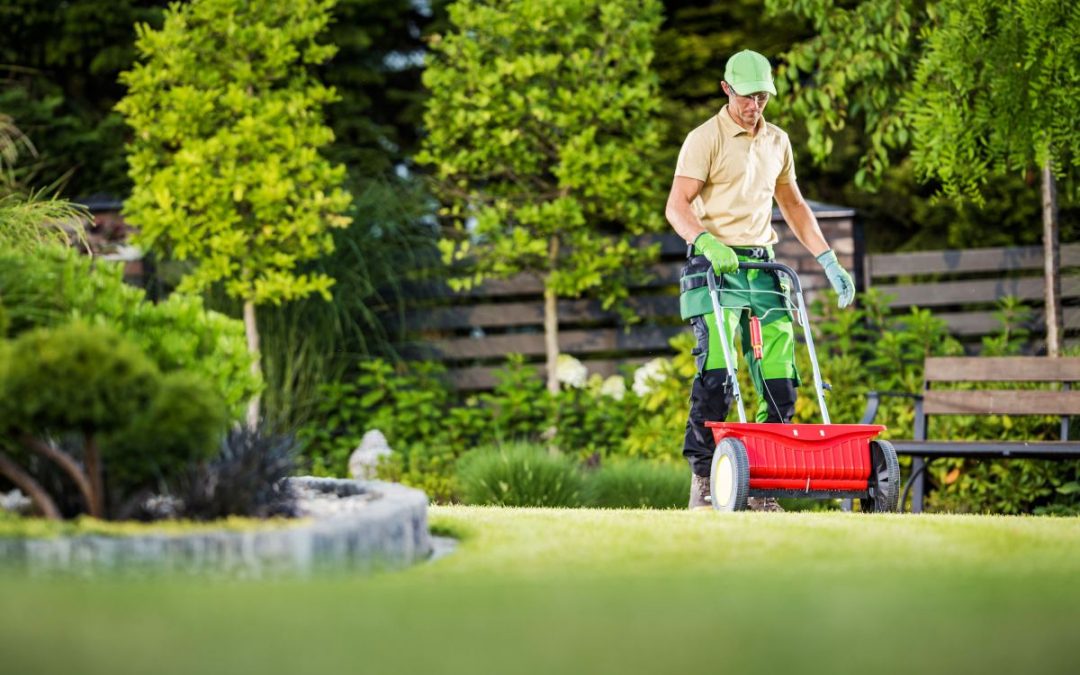You’re ready to take on the beautiful weather, but your lawn is not. Why is it not green when you just applied fertilizer? A yellow lawn that does not green up or look lush and healthy after it has been fertilized can be a sign that it is time for a lime treatment. This article explores why, when, and how to lime your lawn.
In this article:
What is Lime for Lawns?
Lime is a soil amendment that is made from ground limestone. Adding lime to a lawn raises the soil pH level, making it more alkaline and less acidic. The lawn is unable to absorb needed nutrients in acidic soil, which keeps the grass from thriving.
Lime is made from calcium carbonate and other materials, like magnesium carbonate. There are two types of lime: dolomitic and calcitic.
Calcitic lime works well on soils that are not deficient in magnesium.
Dolomitic lime is the most common type of lime used in lawns. It is made from calcium carbonate mixed with magnesium carbonate. Dolomitic lime is higher in magnesium than calcitic lime. If your soil is magnesium deficient, dolomitic lime is the best choice.
Lime for lawns comes in liquid, powder, and pellet form. Each has its advantages and disadvantages. Here are some things to consider for each form:
Liquid
- Fast soil reaction
- Does not leave the dust that powder does
Powder
- Harmful if inhaled
- Nearby surfaces should be cleaned because powder can stick to pavement
- Can be corrosive to plastics if plastics are not appropriately cleaned after exposure
Pellet
- Time released, which provides sufficient yard coverage
- Does not have the breathing risks and clean-up challenges of powder
- Not as dusty as powder
- Spreads more easily than liquid
- More expensive than conventional lime
- Can be attractive to children and pets, potentially causing them to eat the pellets and get sick
Why to Lime Your Lawn
A lawn growing in overly acidic soil will not get the nutrients it needs when it is fertilized. The grass will experience problems and stop growing. When you add lime to your lawn, you raise the soil’s pH level, making it less acidic. This allows the grass roots to absorb the nutrients your grass needs to grow healthy, like calcium, nitrogen, potassium, and phosphorus.
The ideal pH for healthy grass is between 5.8 and 7.1. Your type of turfgrass determines where the soil pH level should fall in this range for optimal lawn growth. Warm-season grasses, like St. Augustinegrass and Zoysiagrass, need a slightly lower pH. Cool-season grasses, like fescues and Kentucky bluegrass, require a moderately higher, more alkaline pH.
When to Lime to Your Lawn
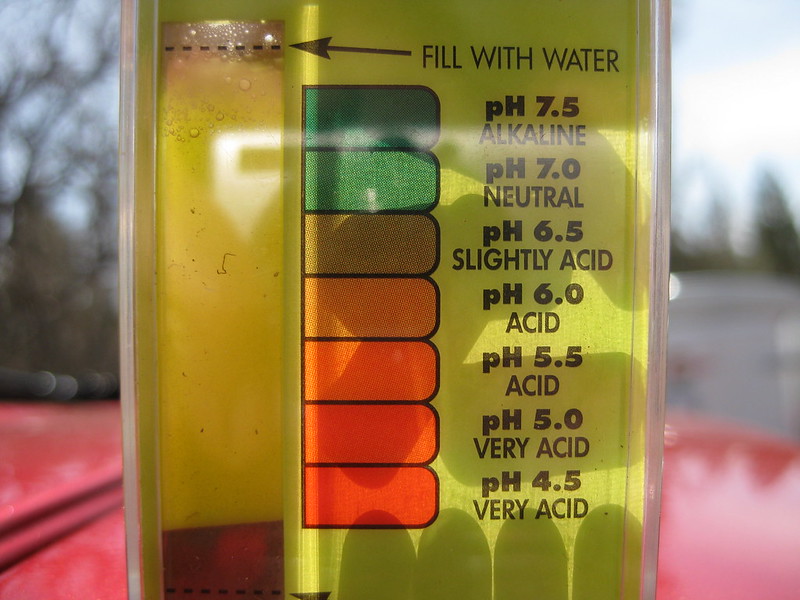
Photo Credit: Ryo Chijiiwa / Flickr / CC BY 2.0
Liming your lawn does not need to be a regular practice. You should only lime a lawn if the soil is too acidic. A soil test will reveal your soil’s pH and nutrient deficiencies, which will tell you whether your lawn needs lime or not.
But what are the tell-tale signs that a soil test is needed? These are indicators that a lawn might need lime:
- Lots of Lawn Weeds: Weeds love acidic soil. Healthy lawns are usually able to smother out weeds.
- Pests and Diseases: Lawn diseases and many lawn pests can be a sign of unhealthy grass. Disease and insect pests usually cannot thrive in healthy lawns.
- Lawn Moss: Since lawn moss prefers a low soil pH, soil too acidic will promote moss instead of strong, thriving grass.
- Unresponsive to Lawn Fertilizer: The grass does not green up and grow full and lush after it has been fertilized.
- Unhealthy Appearance: If the lawn has brown grass, wilted blades, or yellow patches, it is a sign of overly acidic soil.
Best Time of Year to Lime Your Lawn
The ideal time for lime treatments is the fall and spring, with a preference for the fall. Conventional lime products can take months to break down and modify soil acidity. The changes in the weather from fall to spring help these products break down. If you apply lime in fall, it will be broken down by spring, and your soil will be ready for a new year of healthy growth.
Some more advanced lime agents start working immediately and can be applied any season.
How Often Should You Add Lime to Your Grass?
You do not want to add too much lime too often. Soil that is too acidic should be tested annually until it is at the ideal pH level. Give the lime application time to work. If you added lime in the spring, test the soil again in the fall, and vice versa.
Once the soil pH is balanced, test it every 1 to 2 years. Only apply lime again if the pH drops below the ideal range.
When You Should Not Add Lime to Your Lawn
Just like there is an ideal time to lime your lawn, there are also times when you should avoid applying it. To make sure your lime treatment is effective, do not add lime in the following conditions:
- When it is very hot, like in mid-summer
- If there is the potential for frost
- Your lawn is stressed
- The grass is dormant
How to Lime Your Lawn
There are some things you will need to do to prepare your lawn for lime treatment. You will need to know your lawn’s size. Be sure to wear protective gear, like gloves and a mask.
Here are the preparatory and application steps to lime your lawn:
1. Get a Soil Test
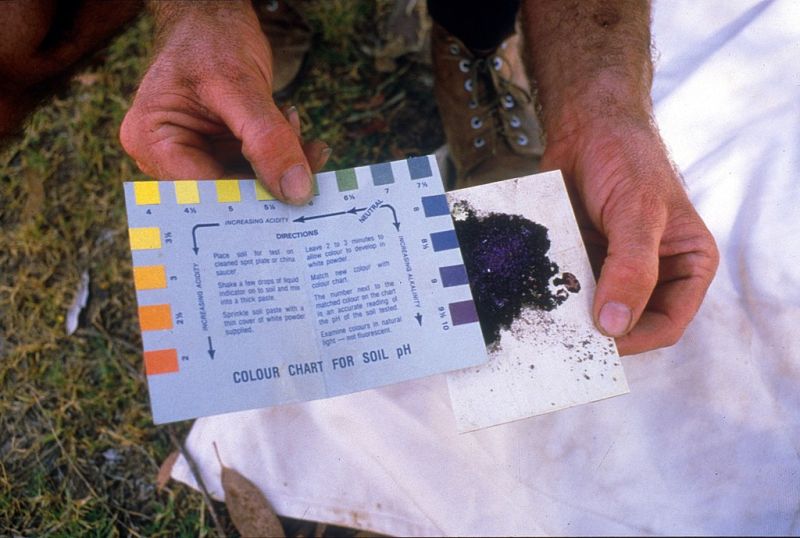
Photo Credit: CSIRO / Wikimedia Commons / CC BY 3.0
Before you lime your grass, always start with a soil pH test. Liming when you do not need to can harm your lawn.
Your soil type will determine the amount of lime you need to add to increase or decrease the soil pH. Homeowners should contact their local county extension office to inquire about receiving a soil test kit and sending in a soil sample. Although a kit can be purchased from a local garden center, the county extension service will provide a more accurate report.
2. Dethatch
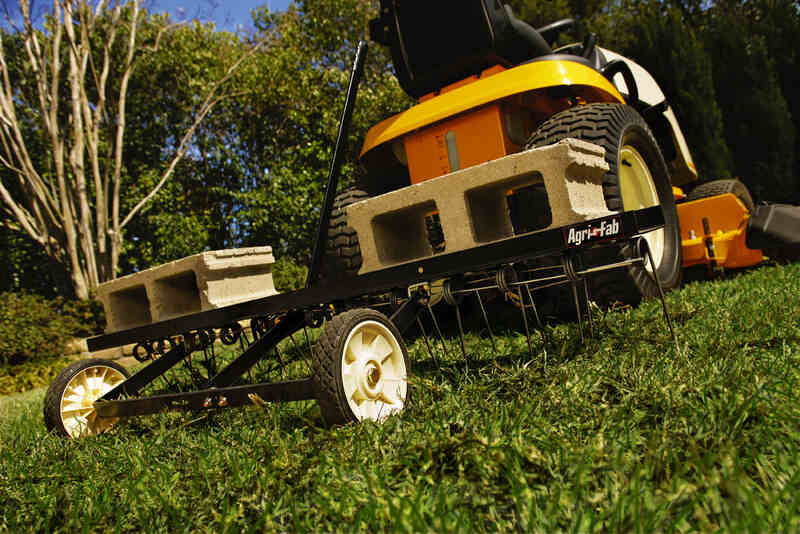
Photo Credit: Agri-Fab, Inc. / Wikimedia Commons / CC0
If there is a significant layer of thatch between the grass and the soil, dethatch the lawn before aerating. Dethatching removes organic debris that could prevent lime from getting to the soil.
3. Aerate
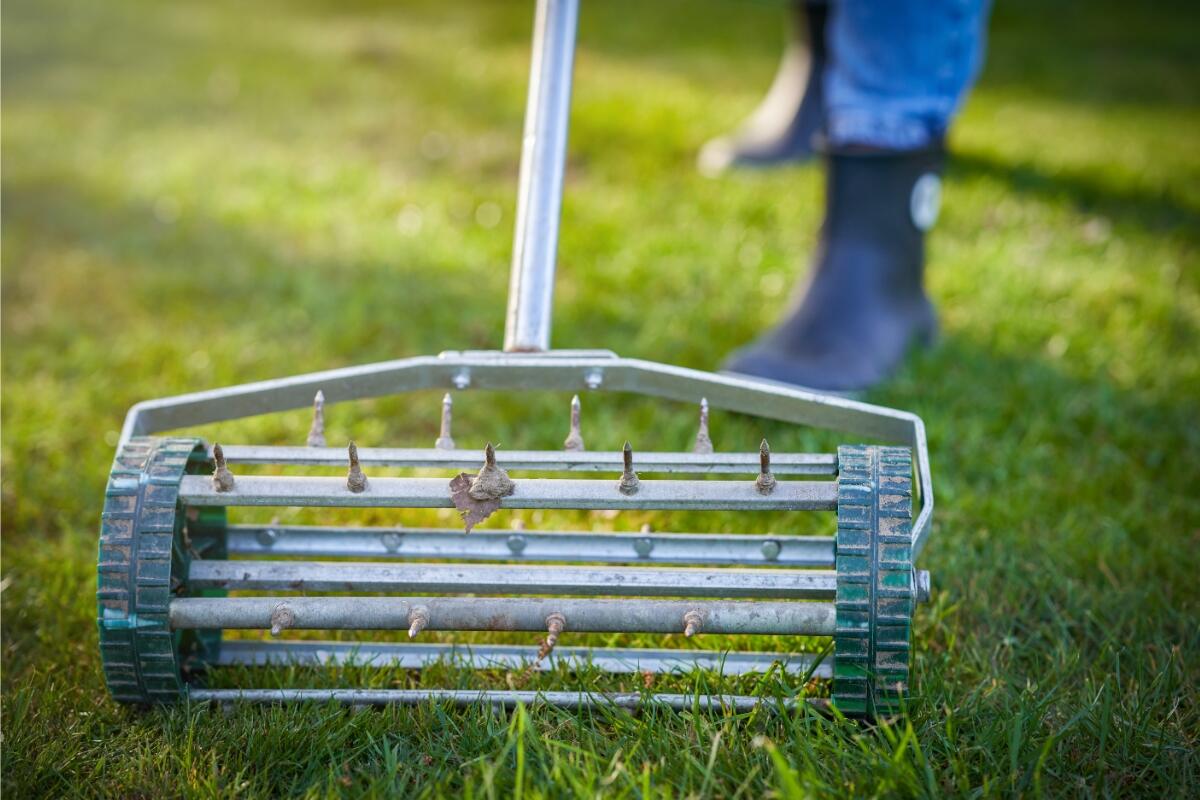
Photo Credit: macniak / Canva Pro / License
Use a core aerator to loosen the soil before applying lime. Lawn aeration opens up small holes in compacted soil, allowing soil amendments like lime to break down more easily.
The dethatching and aeration process does not have to immediately precede lime application. In the case of warm-season grasses, which should not be dethatched and aerated in the fall, it is okay to do so in late spring and add lime in the fall. You can also dethatch and aerate in the late spring and lime afterward.
Cool-season grasses can be dethatched and aerated in the fall right before you add lime.
4. Determine the Amount of Lime Your Lawn Needs
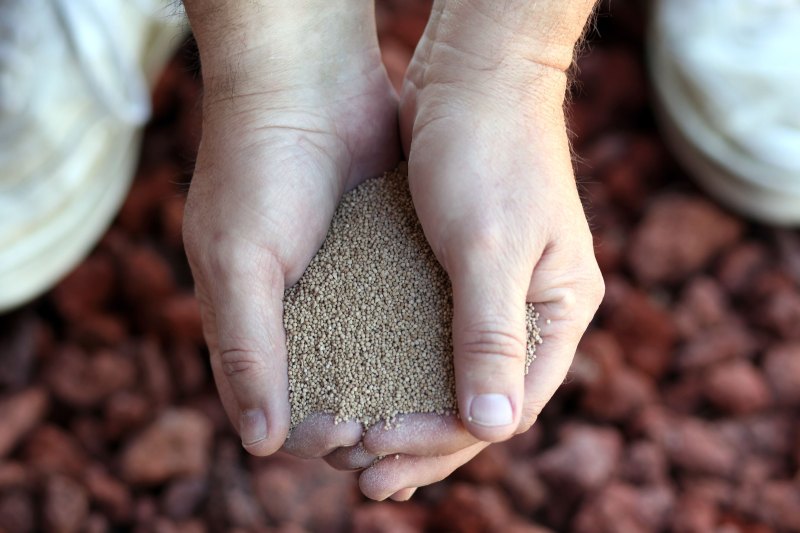
Photo Credit: Imagesbybarbara / Canva Pro / License
The soil test results will typically recommend how many pounds of lime are needed per 1,000 square feet. If the grass needs between 50 and 100 pounds, apply it in two different applications. Administer the first half in the spring and the remaining amount in the fall. Never put more than 50 pounds of lime per 1,000 square feet on the grass at one time.
5. Apply the Lime
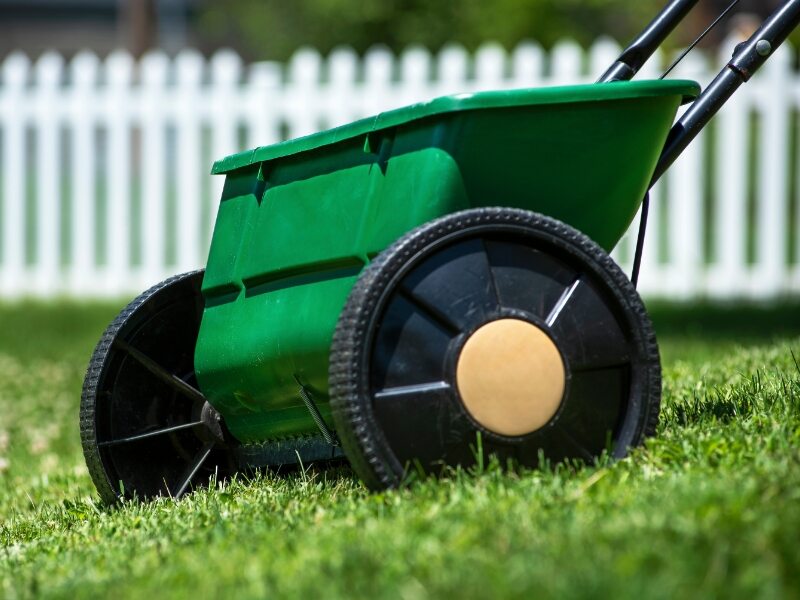
Photo Credit: Jon Rehg / Canva Pro / License
Lime Pellets. Use a drop spreader or rotary spreader and disseminate half of the lime by walking across your lawn in parallel lines, back and forth. After the first round of application, apply the remaining lime by walking in lines perpendicular to your first application. This will increase your chances of thorough coverage.
Liquid Lime. Read the product label to determine how much you will need to apply. Walk across your lawn in straight lines as you spray, just like with pellets. Spray side-to-side as you walk for uniform coverage.
6. Water the Grass
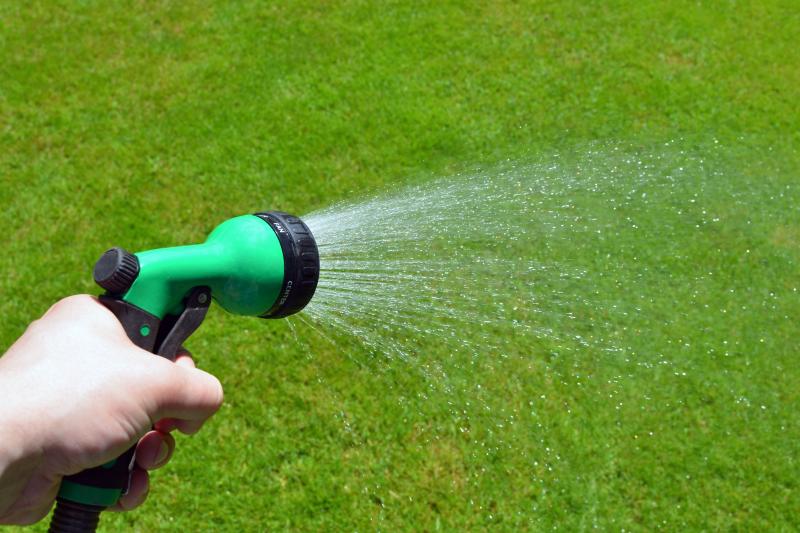
Photo Credit: AnthonyRosenberg / Canva Pro / License
Help the lime soak into the soil by watering the lawn. This will also keep lime from sitting on the grass blades and burning them. For liquid lime, follow the package instructions regarding how soon to water after application.
FAQ About Lime for Lawns
Is it possible to use too much lime?
Yes. A lawn with too much lime can change the pH of the soil to a level that prevents the grass from thriving. It can create overly alkaline soil, preventing grass blades from getting the nutrients they need. The grass can eventually turn yellow and die if too much lime continues to be added.
Is lime toxic to humans and pets?
Homeowners should wear a mask when handling powder lime. Pellet lime may be attractive to pets and children, so be sure to keep them off the lawn while the pellets are still visible. Lime pellets are harmful if ingested and can irritate the skin and eyes.
What causes my lawn’s soil pH to change?
Runoff from heavy rainfall can remove calcium from the soil. Calcium loss leads to a drop in pH and, eventually, acidic soil. If your area does not get heavy rain, calcium is not removed from runoff, and the grass can become overly alkaline. Maintaining your lawn appropriately, including watering and fertilizing it, will also eventually lower the pH level.
Can you lime and fertilize at the same time?
No. If your lawn needs a lime application, that means it is too acidic and cannot properly absorb the nutrients from fertilizer. You’ll need to add the lime first and give it a few months to absorb into the soil. After a few months, test your soil again. If the soil pH is within the appropriate range, you can then fertilize the lawn.
Final Thoughts
Liming your lawn is an art and science. You need to know when to lime, what type of lime to use, the best time of year for lime treatments, and the best form of lime to apply. This is the science. The art is in the ability to produce a beautiful lawn for years to come.
You do not have to deal with the intricacies of liming your lawn and other landscaping tasks on your own. From adding lime to controlling weeds to mowing the grass, WikiLawn can connect you with qualified lawn care pros in your area to handle all your lawn care needs.

